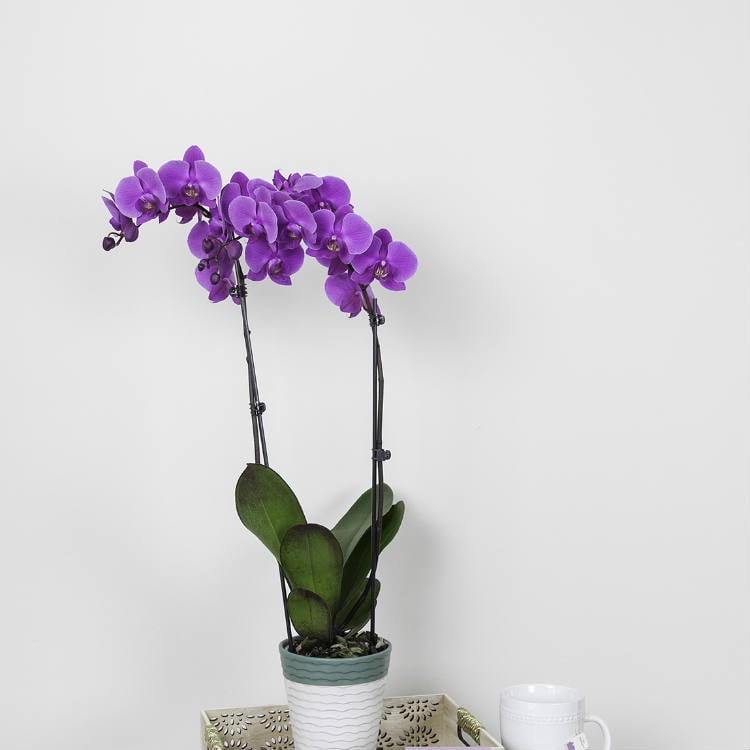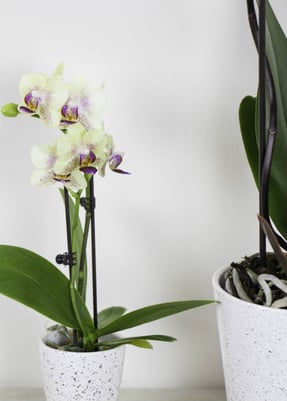
A common mistake novice orchid owners make is assuming their orchid is dead when it stops blooming and enters dormancy. However, in most cases, this couldn’t be further from the truth.
Most likely, what you’re witnessing is your plant entering its dormancy period before reblooming begins again, which is a completely normal part of the orchid life cycle. With a little effort to trigger reblooming, your orchid will be showing off those beautiful flowers before you know it.
Of course, sometimes the underlying cause for orchid bloom loss isn’t quite this simple. There could be an issue in your care methods or in your orchid’s health that leads to bloom loss. By knowing how to recognize the difference between normal orchid bloom loss that is a natural part of the lifecycle and orchid bloom loss that could spell trouble, you can save your plant from a potential health crisis.

First, let’s discuss the type of bloom loss behavior that is completely normal and not cause for concern. If your orchid has flowered for several weeks or months with no issues and the flowers are simply starting to wilt and drop petals, take a deep breath: this is completely normal. With proper care, orchids will bloom for up to three months before entering a resting period.
Related: Orchid Care 101: How Do I Care For a Resting Orchid?
Now, let’s look at a few instances of bloom loss that may require immediate intervention to save the long-term health of your plant.
1. If Your Orchid Isn’t Getting Enough Water
If the roots of your orchid are gray, dry or brittle, it might be a sign that your plant isn’t receiving enough water, which can cause your blooms to fall off prematurely.
Depending on the severity of the water deprivation, you may be able to treat your plant’s condition by taking care to maintain the recommended watering routine. However, if your orchid’s roots are still struggling to stay green and healthy, you may need to try soaking the roots and bark of your plant for two minutes in a bucket, then draining the water off completely.
2. If Your Orchid is Getting Too Much Water
Similarly, overwatering your orchid can be bad for bloom health. If the roots become soggy, your plant may be at risk of root rot, which can harm the buds and blooms. The easiest way to prevent root rot is to stick to our proven method of watering orchids with ice once a week, but you may need to let your orchid roots dry out before continuing your regular watering routine.

3. If Your Orchid Experiences Changes in Temperature
Exposing our orchid to drafts or colder temperatures can lead to bud or bloom blast, where the buds or blooms of your plant suddenly and prematurely fall off. Keep your plant in an area of your home where a consistent, warm temperature is maintained. Your plant should never be exposed to temperatures below 65 degrees F or above 80 degrees F.
4. If Your Orchid Is Placed Next to the Fruit Bowl
 When fruit ripens, it emits ethylene gas, which can also cause bud blast (when buds wither from an otherwise healthy plant) or orchid bloom loss. Treating this problem in your orchid could be as simple as moving your plant away from the fruit bowl, so think twice about displaying your plant in your kitchen.
When fruit ripens, it emits ethylene gas, which can also cause bud blast (when buds wither from an otherwise healthy plant) or orchid bloom loss. Treating this problem in your orchid could be as simple as moving your plant away from the fruit bowl, so think twice about displaying your plant in your kitchen.
By having a clear understanding of what kinds of bloom loss are due to the normal process of re-blooming and what kinds could signal problems, you can be prepared to give your orchid the best care possible.
Want more tips? Download our free orchid care guide.

Copyright Just Add Ice® Orchids 2023